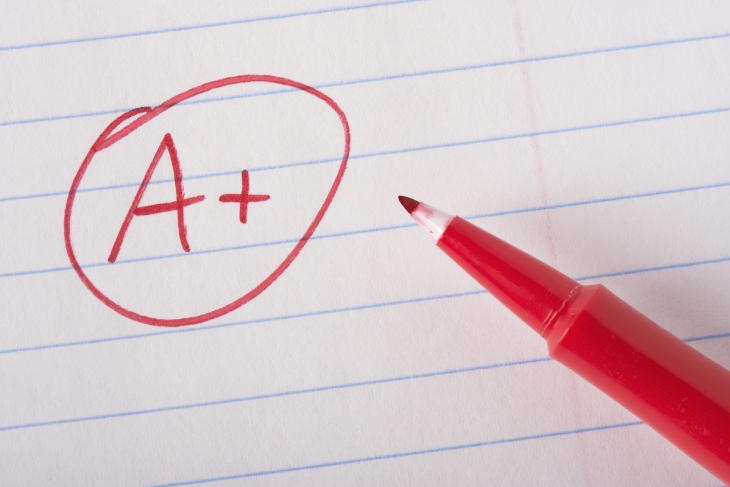Editor’s note: This was first published by Forbes.
America’s high schools have just endured a decade of dramatic grade inflation, according to a new study from ACT. This coincided with a decade of declining academic achievement, raising hard questions for those concerned about instructional rigor, inflated graduation rates, and the integrity of selective college admissions.
Between 2010 and 2022, there was evidence of steady grade inflation among high schoolers. During that period, even as the National Assessment of Educational Progress (the “Nation’s Report Card”) recorded steady declines in reading, math, and U.S. history achievement, student GPAs climbed steadily higher. The average adjusted GPA increased from 3.17 to 3.39 in English; from 3.02 to 3.32 in math; from 3.28 to 3.46 in social studies; and from 3.12 to 3.36 in science. In 2022, more than 89 percent of high schoolers received an A or a B in math, English, social studies, and science.
At a time when schools are struggling to combat pandemic learning loss and graduation rates have climbed to historic highs, there are unfortunate consequences when educators essentially give every student an A or a B. Easy A’s signal to students they don’t need to work hard to succeed, give parents a false sense of how their kids are doing, and allow students to graduate without essential knowledge or skills. They also undermine learning, as researchers at Brown University and the Thomas B. Fordham Institute have found that students appear to learn more from teachers who are tough graders.
This is hardly the first time we’ve seen evidence of grade inflation. These results reinforce a decades-long trend. For instance, the 2019 National Assessment of Educational Progress High School Transcript Study, issued by the National Center of Education Statistics, found that America’s students were getting better grades and (putatively) taking more rigorous classes than students a decade before, but actually learned less.
In 2009, Mark Schneider, currently the director of the federal Institute of Education Sciences, found that the share of students completing algebra II grew one-third between 1978 and 200 and that average math GPAs rose markedly between 1990 and 2005 and, yet, student test performance in algebra I, geometry, and algebra II actually fell between 1978 and 2008. In short, impressive-sounding classes and rising grades masked a decline in student learning.
What’s driving this trend?
For one thing, a number of education leaders, advocates, and experts appear to be increasingly uncomfortable with traditional notions of rigor or grading. Indeed, the burgeoning push for “grading equity” (with districts eliminating the “zero”, eliminating penalties for late work, and allowing repeated re-tests) is premised on the belief that grades are often arbitrary or unfair. Author and speaker Cornelius Minor teaches, for instance, that one “cannot separate grading practices” from “the history of classism, sexism, racism, and ableism in the United States.”
Meanwhile, parents and students have become increasingly assertive over time, and many school leaders and educators have decided that it’s easier to appease them than to fight them. Just last month, Intelligent.com reported that 44 percent of educators say that students today often ask for better grades than they’ve earned. Four out of five educators say they’ve given into these demands, a reaction that’s easier to understand when one sees that 38 percent say they’ve been harassed by students (and 33 percent by parents) over grades.
What can we do about all this? There are at least four places to start.
First, it’s crucial to appreciate that grade inflation isn’t a victimless crime. It sends a false signal to students and families, making it tougher for educators to encourage students, acknowledge hard work, or give honest feedback. It can mean that selective college admissions become more about connections and game-playing than about earned opportunity.
Second, for teachers squeezed between helicopter parents and ideologues, it can be difficult to hold the line on high expectations. Education leaders who take their mission seriously need to recalibrate expectations, stand up for rigor, and support classroom teachers more, making clear that they regard runaway grade inflation as a problem.
Third, there’s a crucial role for states, which should ensure that graduates are mastering essential knowledge and skills. Issuing students meaningless diplomas isn’t doing anyone any favors. Accountability testing and graduation exams are good tools for keeping things in check.
Finally, colleges should take care to ensure they’re using credible measures of student preparation, which suggests a U-turn for all the schools that have ditched the SAT or ACT. Keep in mind that Harvard University’s Raj Chetty has reported that, contrary to the claims of anti-testing ideologues, selective colleges which embrace admissions testing are more likely to enroll low-income students than those which rely on grades, interviews, essays, and other similar inputs.
Grade inflation can feel like an abstract problem but it has real, troubling consequences for students, parents, and educators. We need to do better.


